
December 8th, 2016
How Using a Roof Rake Can Make Ice Dam Problems Much, Much Worse
You may have read that removing snow from your roof will prevent ice dams, and for the most part that is true. Ice dams get their fuel (i.e., water) from the snow on your roof after all. Remove the snow, remove the problem. So this winter you buy a roof rake, brave the cold and remove as much snow from you roof as you can, leaving a section of snow still in place higher on the roof that you couldn’t reach. A few weeks pass and bam! You see water leaking through your ceiling. How can this be? The answer lies in a phenomenon we call the ‘double dam’, something we have seen over a hundred times in the past decade alone. Our graphic below helps explain the how and why.
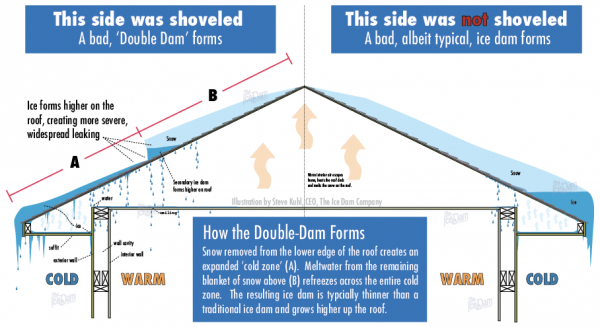
Ice Dams Prevention: How Much Snow Should be Shoveled From a Roof?
Of the two ice dams illustrated above, the Double Dam presents a couple of challenges beyond those of the regular ice dam. First, because ice has grown further up the roof slope, the subsequent leaks inside will cover a wider area. The second problem with a Double Dam is the cost of removal. Although half the thickness, it may take two to three times longer to remove than a regular ice dam. More time equals more money.
Shown below is a very typical Double Dam. This home in Minnetonka, Minnesota had been leaking from both ice dams and the cost to remove them was tremendous. Area A is where the average ice dam likes to form. Area B only forms when someone does an incomplete snow removal job from the roof. So what is the take-away from this case study? Remove all the snow from roof slopes that may produce an ice dam or remove none at all. While the latter may result in an ice dam happening on the lowest edge of the eave, at the very least it won’t be a Double Dam.
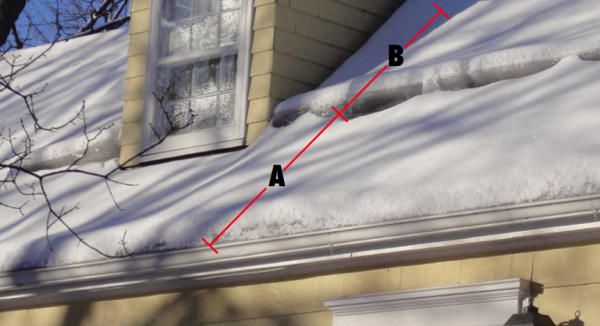
To read more Case Studies click here.
Posted in Ice Dams, Misc.
December 8th, 2016
Observations on the Effectiveness of Ice Melting Compounds on Ice Dams
Can Dad’s Old Pantyhose Save Your Home?
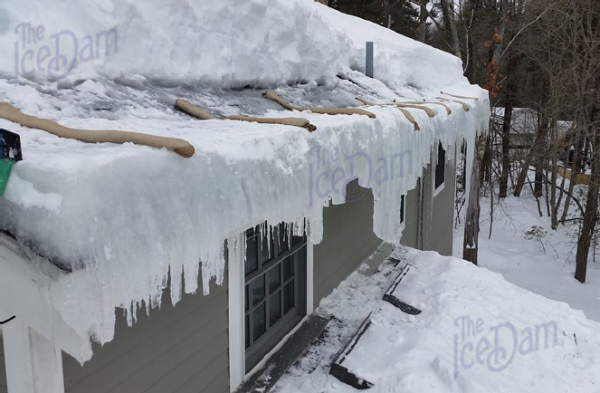
Over the past 25 years we have seen many different methods used to address ice dams. More often than not those measures are reactive, not proactive. Thus is the case of the lowly salt sock, otherwise known as a cloth tube of some sort filled with an ice melting compound of some sort.
Salt socks work on the principle that the ice melting compound is contained in a linear form which, when laid across an ice dam, will melt a channel through the ice. That path would then presumably be used as an escape route for water that may tend to get trapped behind the ice dam. The purpose of the sock is to hold the ice melting material in place, thereby concentrating the melting action. (Yes, that was a cross-dressing joke about dad).
Concept Vs. Reality
The only problem with the sale sock is that it simply doesn’t work. The examples below show typical results. In theory, salt socks seem like a great idea. In practice, however, using them to deal with an ice dam is not practical. One problem is that in order for them to do their intended job (Cut channels through the ice dam) they need to be placed somewhere meticulously, every 16″ or so. That’s a lot of socks. Next, we see that they tend to only melt about 90% down through the ice dam and then putter out. We have no idea why they don’t melt a clean slot right down to the roofing material but it never happens? The net result is that the melt water that causes ice dams, and the leaks that follow, still can not find a way off the roof. That’s bad. Perhaps the most dangerous part of using salt socks (outside of balancing on a ladder to position them all perfectly) is that they create a false sense of hope. Homeowners tend to ‘install’ them and not look back. That is, until water is dripping through the ceiling.
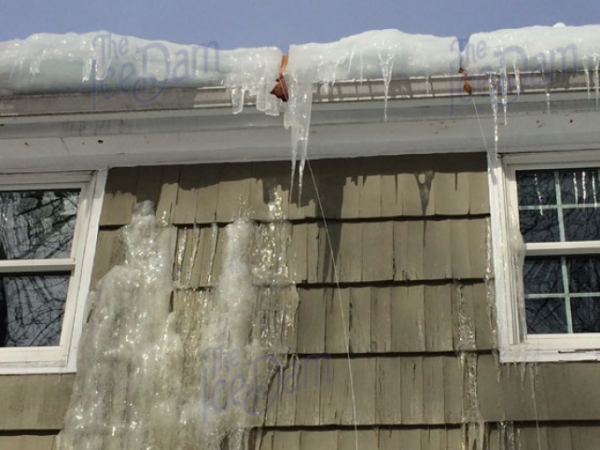
These salt socks didn’t melt down to the roof, resulting in massive water damage to the interior walls. (Can you find the ice on the siding?)
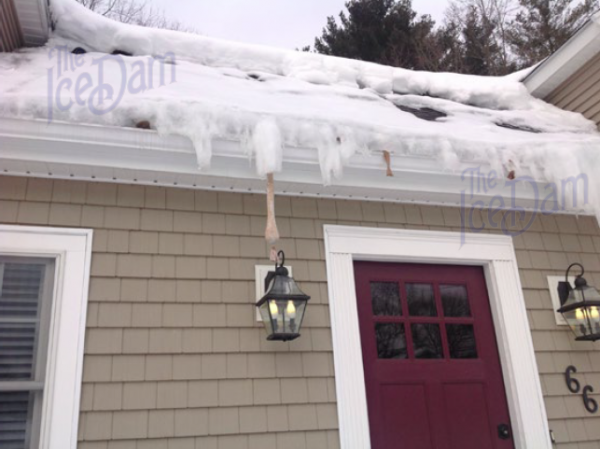
Sad and ineffective pantyhose, encased in ice.
Here’s the bottom line: Don’t use salt socks or pantyhose filled with ice melting compounds to manager your ice dam problem. It simply doesn’t work.
To read more Case Studies click here.
Tags: about ice dams, best ice dam removal in minneapolis, best rated ice dam removal contractor, highest rated ice dam removal company in minneapolis, ice and snow removal, ice dam expert, ice dam heat cable, ice dam removal jerks, ice dam removal with pantyhose, pantyhose and ice dams, right vs wrong way to remove ice dams, salt socks and ice dams, signs of an ice dam problem, twin cities ice dam remover
Posted in Ice Dam Prevention, Ice Dam Removal, Ice Dams, Misc., Water Damage
December 8th, 2016
How Roof Pitch (Roof Slope) Affects the Impact of Ice Dams on Standard Residential Construction
Fact: The Flatter the Roof, the Less Ice it Takes to Cause Problems
As discussed in previous Ice Dam Company blogs and Case Studies, there is a strong relationship between roof slope and the timing and likelihood of damage as the result of ice dams. Specifically, low roof slope areas are far more susceptible to damage by small ice accumulations than areas of steeper slope. Why? It comes down to basic geometry. Study the diagrams, below. You can see that the high slope roofs (C) require a pretty thick ice dam to form before water will begin leaking into the home. Eave depth plays another important role. See Case Study #10 for more information.
Ice dams create leaks when melted water from higher on the roof slope hits a dam of ice and is forced to travel backwards, up and under the plus of the roofing system (typically asphalt shingles). When that backward motion occurs outside the plane of exterior wall (dotted red lines in diagrams), the water runs down the exterior wall or through the soffits (zone indicated by happy face). As soon as the water falls on top of the top plate of the wall it seeps down through the wall causing damage to insulation, finishes and flooring (zone indicated by sad face). Truthfully, water coming through your soffits is nothing to be happy about. The next step is the interior of your home so it is considered an emergency in terms of the progression of the ice dam. As mentioned before, if you see ice coming through the soffit or down the exterior wall, it’s time to get that ice dam removed.
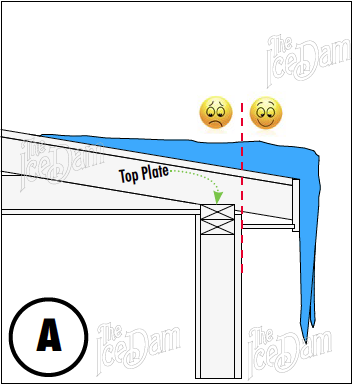

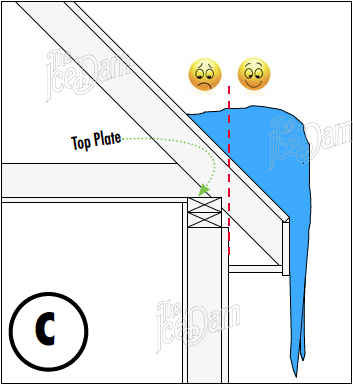
Wayzata Residence with Low Pitch Roof Suffers the Consequence
Seen below is a home in Wayzata, Minnesota where we steamed an ice dam a couple of years ago. The construction assembly was typical 2×6 walls, 12″ eaves, 6″ facia with a 2/12 roof pitch. From the ground, no ominous, threatening icicles could be seen, just a couple of pathetic whiskers of ice off the face of the gutter through the soffit (D). Pan out and you see that the entire exterior wall was bleeding ice through the siding. This is bad. This home had massive damage to the interior insulation, drywall and flooring systems.
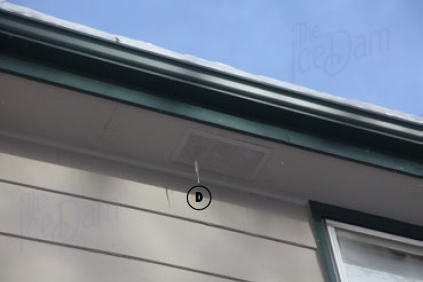

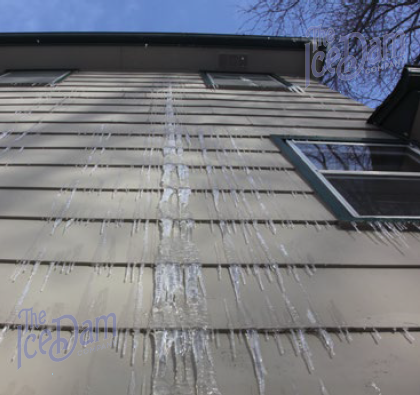
As discussed in Case Study #06, low pitch roofs also tend to create ‘deeper’ ice dams (E), where the ice has grown further up the roof. Deep ice dams take far longer to remove.
Three take-aways:
- No icicles does not mean no ice dams.
- Low pitch roofs present higher risks in terms of how quickly small ice dams can cause big problems.
- Ice or water coming down the exterior wall in below freezing conditions is bad. Very, very bad.
To read more Case Studies click here.
Tags: about ice dams, best ice dam removal in minneapolis, best rated ice dam removal contractor, commercial ice removal, edina ice dam removal, edina ice dam steaming, highest rated ice dam removal company in minneapolis, how do I know I have ice dams, ice and snow removal, ice dam expert, ice dam heat cable, ice dam prevention, ice dam removal jerks, twin cities ice dam remover, wayzata ice dam removal
Posted in Ice Dam Prevention, Ice Dam Removal, Ice Dams, Misc., Ice Dams: General Info, Water Damage
December 5th, 2016
1. Water Damage
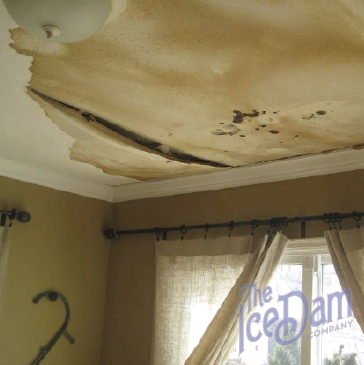
2. Ruined Insulation
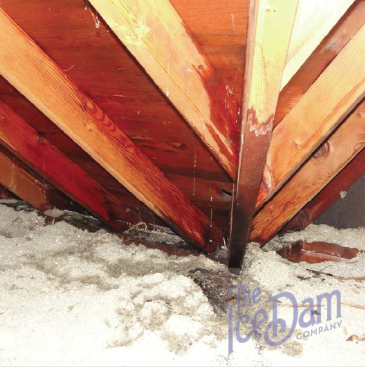
3. Mold and Mildew
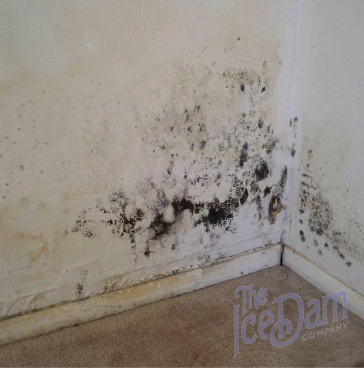
4. Gutter Damage

5. Property Damage
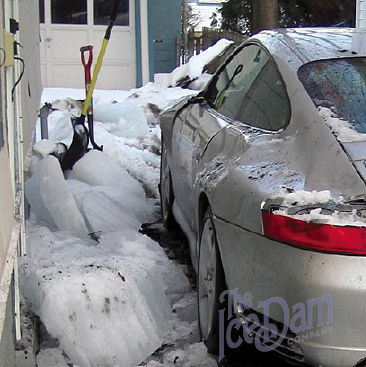
6. Soffit Damage

7. Landscaping Damage
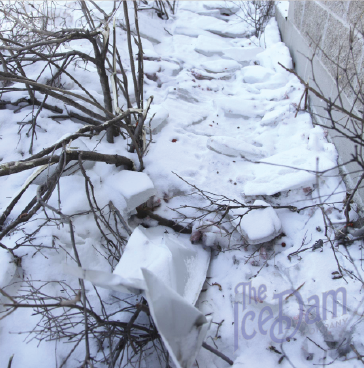
8. Falling Ice
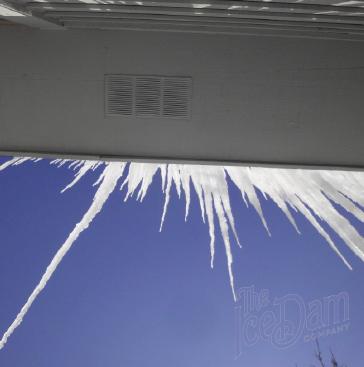
9. Flooring Damage
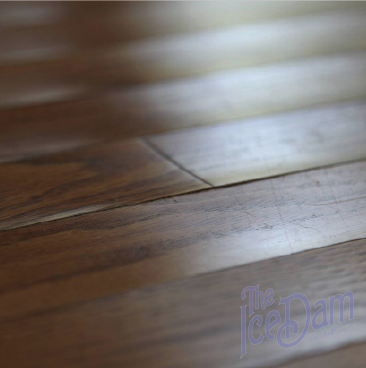
To read more Case Studies click here.
Tags: about ice dams, best ice dam removal in minneapolis, best rated ice dam removal contractor, commercial ice removal, edina ice dam removal, edina ice dam steaming, gutter deicing wire, highest rated ice dam removal company in minneapolis, how do I know I have ice dams, how to file an insurance claim for an ice dam, ice and snow removal, ice dam expert, ice dam removal jerks, minneapolis ice dam removal, orono ice dam removal, roof ice steaming, twin cities ice dam remover, wayzata ice dam removal
Posted in Ice Dam Prevention, Ice Dam Removal, Ice Dams, Misc., Ice Dams: General Info, Water Damage
December 1st, 2016
How Much Should it Cost to Have an Ice Dam Removed: Ice Dam Steaming Costs Explained by The Ice Dam Company
Ice Dam Removal: Pricing Vs. Cost
As mentioned in Case Study #05, there is a big difference between price and cost when trying to figure out how much your ice dam removal project will cost. The price is what someone tells you over the phone, normally relating to what they charge per hour for their ice dam removal services. We made a list of the 8 most common factors in determining the cost of ice dam removal in Case Study #05. Here is an examination of one major driver in ice dam removal cost: The depth of the ice dam.
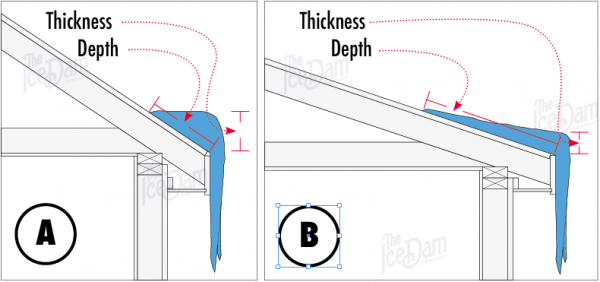
Which takes longer to remove?
Intuition might suggest that thicker ice dams (A) take longer to remove then thinner ice dams (B). Not true. The main factor in the ice dam removal cost is how far up the roof the ice has grown. We refer to this as the ‘depth’ of the ice dam. Deeper ice dams take much longer to remove than those that are thick but shallow.
Estimating the Cost of Ice Dam Removal by Steam
You might think that after having removed thousands of ice dams around the country over the past 25 years we would be able to provide an accurate estimate over the phone as to how long a project might take. Sadly, we can’t. Anyone offering a guaranteed timeframe for ice dam removal projects over the phone is frankly full of it. We know that we can often remove between 10-15 feet of ice dam as measured along an eave every hour after the equipment is set up (C), below left. We know that there are many factors that determine the ultimate length of the ice dam steaming time, as discussed in Case Study #05. One of the main project timeframe drivers is ice dam depth and it can not be known until an experienced eye sees it and that can’t be known until the snow has been removed from the area. Until the ice dam is fully exposed it is impossible to know how long it will take to remove it. In the photos below, the ice dam on the right took three times longer to steam off than the ice dam on the left, even though it was 1/3 the thickness and the roof was a ‘walker’. It’s all about how far up the roof the ice has grown.
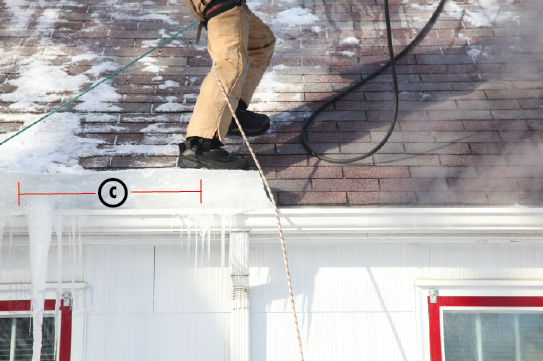

To read more Case Studies click here.
Tags: about ice dams, best ice dam removal in minneapolis, best rated ice dam removal contractor, edina ice dam removal, highest rated ice dam removal company in minneapolis, ice and snow removal, ice dam expert, ice dam heat cable, ice dam prevention, Ice dam removal, minneapolis ie dam removal, twin cities ice dam remover
Posted in Ice Dam Prevention, Ice Dam Removal, Ice Dams, Misc., Ice Dams: General Info
November 25th, 2016
How to Figure Out if the Leak is from Ice Dams or from Something Else?
As discussed in Ice Dam Company Case Study #03, ice dams can form in many locations on the typical home. The eave (lowest edge of the roof) is the most common area for ice dams but we find them around other areas including skylights, in valleys and in low-pitch roof pans and saddles. Many times a winter we get calls from concerned property owners who are experiencing leaks – or at least that is what appears to be happening – because they see water, moisture or discoloration on the ceiling. It’s logical, after all, to assume the roof is leaking when one sees that sort of thing. But the fact of the matter is that winter roof leaks can be attributed to a few potential sources. Here are a few of the common sources:
Plumbing Leaks
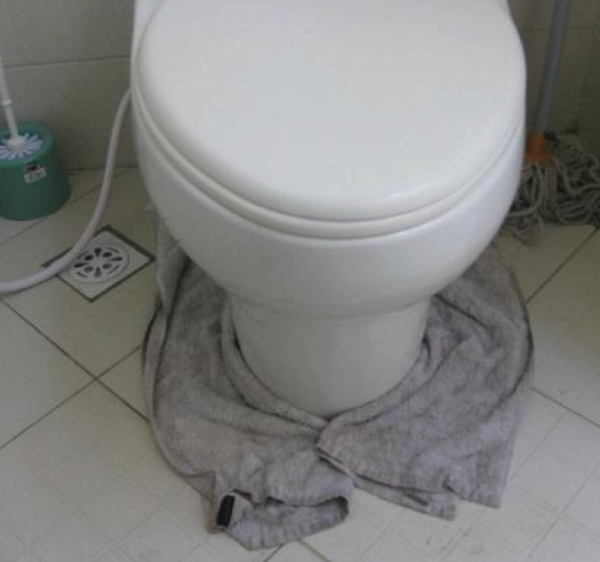
Is the leak in close proximity to a plumbing fixture, water supply or drain line? The most common sources of plumbing related leaks in homes are associated with failing shower pans, over-flowed bathtubs and faulty caulking or bad wax rings around toilets. Water can travel many feet from the source before it finds the path of least resistance and shows up. It’s typical to see water coming through penetrations through the ceiling such as recessed lights and at sheetrock seams many feet from the leak source. Plumbing failures can occur at any time during the year. When they happen in the winter, homeowners often assume its an ice dam. Plumbing leaks can be tricky to find and fix. Our favorite tool to find this type of leak is the thermal imager. This is a special camera that sees through walls and ceilings to detect differences in temperatures.
Attic Frost and Attic Condensation
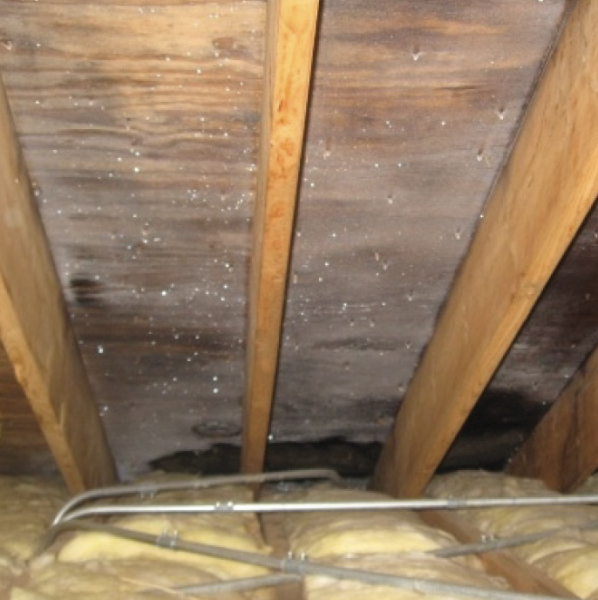
If possible, it can be tremendously helpful to peak into the attic. A healthy attic with good ventilation (Ice Dam Company Case Study #17) should not present moisture or frost on the framing members or roof decking. The photo, right, shows a poorly insulated, ventilated and air-sealed attic. Notice the frost on the underside of the roof decking? This is not good. Attic frost can cause tremendous damage and is most likely to accumulate when temps are quite low (below 10°F). Warm, moist air meets the ice-cold roof deck and freezes into frost. This cycle continues until as much as 1/8″ and 1/2″ of frost has built up. When outdoor temps rise above freezing, all of that frost melts and has nowhere else to go by the interior of the house. This type of ‘leak’ is tricky because it is actually not a leak. We have seen clients spend thousands of dollars trying to resolve a roof leak that was in fact nothing more than attic condensation. Future Ice Dam Company Case Studies will discuss how we fix this issue.
Exhaust Vent Condensation
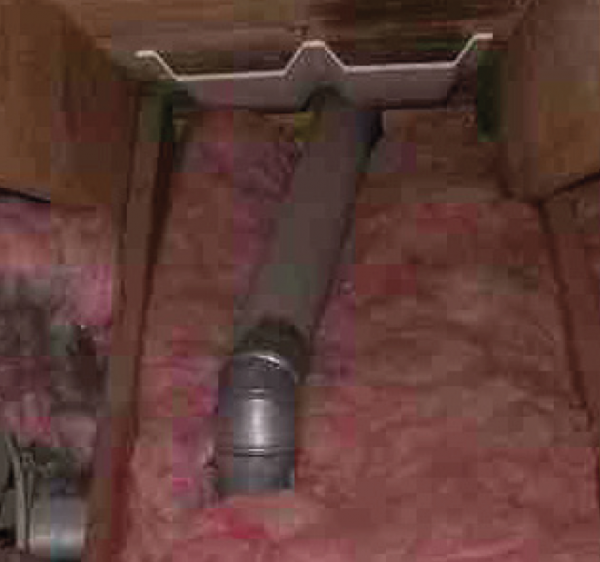
This is a very popular source of the winter roof ‘leak’ phone call we receive. Similar to attic frost-related leaks, this problem is related to the accumulation of frost inside an exhaust vent, commonly a bath vent duct where it travels through an unheated attic. A quick review of the temperature variations from the previous week is a good clue that we may be dealing with an exhaust vent condensation issue. If we had a number of days with extreme cold (highs in the single digits) followed by a thaw (highs in the mid-high 30’s) our first guess without even visiting the home is that the source of the moisture is a condensation issue, not a roof leak. Of course, a thorough site inspection is essential in confirming our suspicions. In almost all cases when exhaust vents are the culprit the leak shows up in the bathroom. Future Ice Dam Company Case Studies will discuss how we fix this issue.
Last but Not Least…Ice Dams
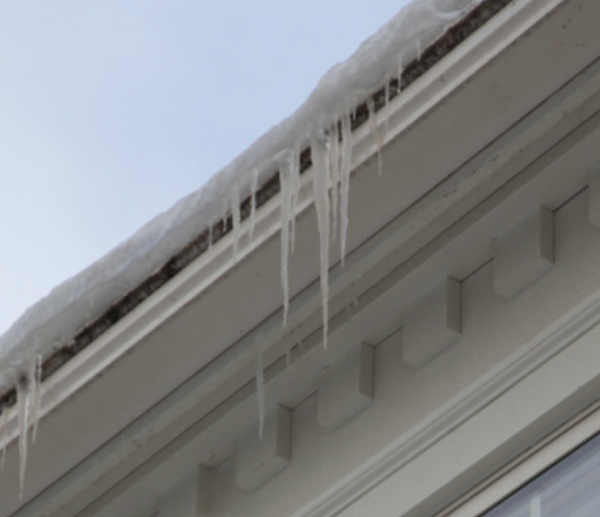
Do you see icicles on the eave near the leaking area? Do you see an ice dam? While not always the case, ice dam causing leaks are usually plainly visible from the ground (See Ice Dam Company Case Study #20). The steeper your roof pitch, the more ice it takes to create interior leaking (See Ice Dam Case Study #09). If you have a low-slope roof area, accumulations as little as 1″ thick can cause problems. Likewise, a heavy blanket of snow can hide the significance of an ice dam, making it hard to ascertain it’s size. Ice Dam Company Case Study #01 and #02 describe some easy things to look for in determining if you have an existing ice dam issue. In our experience, it is unusual to get roof leaks cause by ice dams when no appreciable ice accumulations can be seen from the ground. It can happen, however. It is common to see water/ice coming through the soffit or down the exterior wall when ice dams have developed to the point where they are forcing water to back up into the roofing system.
To read more Case Studies click here.
Tags: about ice dams, best ice dam removal in minneapolis, how to tell if an ice dam is a problem, ice dam removal jerks, identifying an ice dam, Roof Leak, twin cities ice dam remover, water damage
Posted in Ice Dams, Misc., Ice Dams: General Info, Water Damage
November 15th, 2016
The Fundamental Underlying Cause of Most Ice Dams
We have spent a lot of time discussing the finer points about ice dams over the years. This Case Study is about pulling the focus back to the most global understanding of why ice dams happen.
What Causes Ice Dams
There are over a dozen factors that contribute to the formation of ice dams, all of which have been discussed in previous Case Studies. Fundamentally, only one condition MUST be met in order for ice dams to form: A temperature differential from one area of a roof assembly to another area, with the upper area being above 32° and the lower area being below 32°. See below.
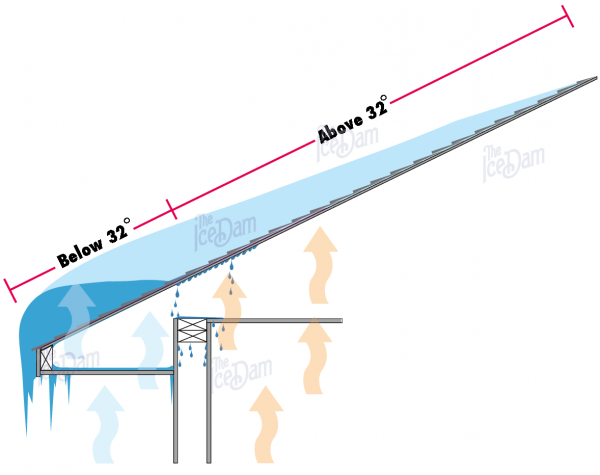
How it Works
This diagram demonstrates the basic concept behind ice dam formation. Snow melts in the area above 32°, water runs down to the area below 32° and refreezes. This cycle continues until an accumulation of ice forms that is large enough to block water from flowing naturally off the roof. The resulting ‘ice dam’ forces water to back up under the roofing materials and into the structure. There are many intersecting variables that cause the phenomenon described here. See below.
List of 7 Contributing Factors to Ice Dam Formation
- A period of outdoor temperatures ranging between 0°-10° at night followed by daytime temperatures between 10°-20°.
- Repeated snow falls that keep the roof loaded with new snow resulting in at least 6″ of coverage at all times.
- Thermal inefficiencies in the home that allow warmth to heat up the roof deck from the underside.
- Homeowner lifestyle that results in excessively heated spaces (More heat equals more roof snow melting).
- Roof pitch: Flatter roof pitches tend to be more affected by problematic ice dams.
- Eave depth: Smaller eaves tend to be more affected by problematic ice dams than deeper eaves.
- Age and construction style of home: Older homes tend to be more affected than newer homes.
To read more Case Studies click here.
Tags: about ice dams, best ice dam removal in minneapolis, best rated ice dam removal contractor, highest rated ice dam removal company in minneapolis, how do I know I have ice dams, how to tell if an ice dam is a problem, ice and snow removal, ice dam heat cable, ice dam prevention, Ice dam removal, ice dam removal jerks, twin cities ice dam remover
Posted in Ice Dams, Misc., Ice Dams: General Info
November 1st, 2016
Steaming Ice Dams is the Fastest, Safest Way to Remove Ice Dams in Minneapolis
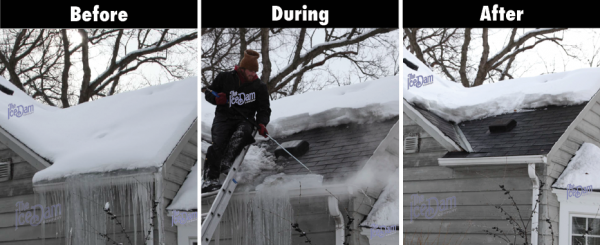
Why Use Steam?
When used properly, a commercial ice dam steamer is the best way to quickly and safely remove an ice dam or other unwanted ice accumulation. Like anything else, it’s possible to use a steamer improperly and damage property. That’s why you should hire an experienced ice removal company. Far more common is damage done to roofs using high temperature pressure washers. Most of our competitors that claim to be using steam are actually using high temp pressure washers. It’s the dirty little secret in our industry. Want to know the easiest way to tell the difference between a steamer and a high temperature pressure washer? If the gun has a trigger, it is NOT a steamer. It’s that simple. More information about Ice Dam Steamers vs High Temp Pressure Washers can be found here.
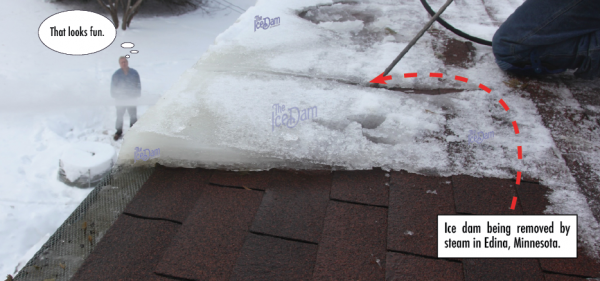
Ice Dam Company is a certified member of IDSAFE : the Ice Dam Steaming Association For Education.

Ice Dam Steaming Association For Education
To read more Case Studies click here.
Tags: about ice dams, best ice dam removal in minneapolis, best rated ice dam removal contractor, edina ice dam removal, edina ice dam steaming, highest rated ice dam removal company in minneapolis, ice dam removal jerks, ice removal company, ice removal professionals, lake minnetonka ice dam removal, minnepolis ice dam removal, orono ice dam removal, roof ice steaming, signs of an ice dam problem, twin cities ice dam remover, wayzata ice dam removal
Posted in Ice Dam Prevention, Ice Dam Removal, Ice Dams, Misc., Ice Dams: General Info
October 15th, 2016
How the Distribution of Snow Can Affect the Formation of Ice Dams
Snow and Ice Dams
There is a complex relationship between snow and ice dams. Yes, you need snow to get ice dams. Snow is, after all, the fuel that feeds the formation and growth of ice dams. Furthermore, it is unlikely to get ice dams unless there is an ongoing layer of snow on your roof over a period of time (normally at least 7-10 days). But it takes more than just having snow on your roof to get ice dams. See Ice Dam Company Case Study #23 for a list of contributing factors. One factor that seldom gets discussed is the affect of wind on the formation and severity of ice dams. While this is not a primary factor, it is something worth exploring. This Ice Dam Case Study looks at the affect a thinning snow cover has when seen on a roof slope that also faces the sun. The affect described below is exacerbated by the presence of darker roofing materials as they absorb more solar energy than lighter materials.
Mountains and Roofs Share Something in Common
Any skiers out there? Wind speeds increase near the ridge of a roof just like the top of a mountain. Snow on one side of the ridge is often swept away while remaining in place just on the other side of the peak. This phenomenon can affect both sides of a roof if wind direction changes from day to day, leaving the snow coverage thin or non-existent on the upper few feet of the roof below the ridge.
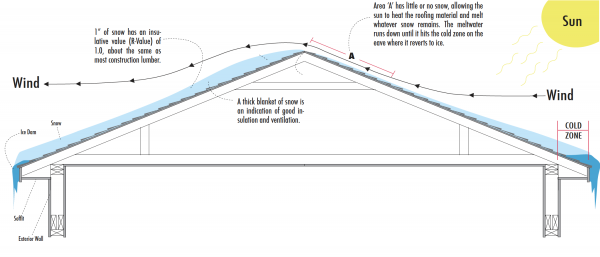
Condensation, The Silent Killer
The lack of an insulating snow blanket can allow heat from the inside of the home to meet cold exterior air in a thinner ‘conduction plane’. When heat hits a thin surface such as a roof decking, where there is a great temperature differential from one side to the other, condensation is also likely. Think of frost on old, single paned windows. The more space there is between the heat and cold, the more room there is for this interaction, greatly reducing the likelihood of condensation. A thick blanket of snow is a perfect insulator for this purpose. It creates more separation between the warmth being lost from the home and the frigid exterior air. Homes with thick snow coverage on their roofs generally seen as more efficient because heat is not escaping through the roofline to reduce the snow through melting.
To read more Case Studies click here.
Tags: about ice dams, best ice dam removal in minneapolis, best rated ice dam removal contractor, highest rated ice dam removal company in minneapolis, how do I know I have ice dams, how to tell if an ice dam is a problem, ice and snow removal, ice dam expert, ice dam removal jerks, ice removal company, minneapolis ie dam removal, steamer
Posted in Ice Dams, Misc., Ice Dams: General Info
October 1st, 2016
There is a lot of misinformation out there on the topic of ice dams. Our goal here is to be the single definitive source for all things relating to ice dams. Towards that end, here are some common misconceptions about ice dams, roof snow, roof ice and gutter ice removal.
FACT: Ice dams can occur with virtually no snow on your roof. It’s a question of ice accumulations. It takes very little actual moisture to form ice dams. Even a dusting of snow can create a problem. Of course it is most often the case the thick snow accumulations create ice dams more quickly, but don’t be fooled into complacency because it’s a low snow season. See Case Study #09.
FICTION: Gutters have something to do with ice dams. The truth is gutters have nothing whatsoever to do with ice dams. See Case Study #03 for proof. If your home is prone to ice dams you will get them regardless of whether or not you have gutters. If you have gutters they will fill with ice and provide a foundation for the ice dam above. True. If you don’t have gutters, the ice dam simply builds on the cold edge of the roof. We provide ice dam removal for many homes each year that do not have gutters. In fact, some of our repeat clients have removed their gutters upon the advice of a dumb person only to be shocked that the ice dams came back the season after. Whoops.
FACT: Gutter systems can be damaged by ice. We see it every year. A section of otherwise fine gutter is either on the ground or hanging pathetically off the edge of the roof, filled with ice. Ice weighs about 60 pounds per cubic foot and gutters are not designed to tolerate that sort of load. It’s important to initiate gutter ice removal sooner than later for this reason. See Case Study #11 for common ice dam damage.
FICTION: When it comes to insulation, the more the better. Improperly insulated homes are just as bad as under insulated homes when it comes to ice dams. We have fixed countless bad insulation jobs for this reason. Specifically, we frequently find insulation done in such a way as to inhibit proper ventilation. Moreover, if you don’t address air leakage into the attic or rafter spaces, all the insulation in the world won’t prevent ice dams. See Case Study #04 for details about good eave ventilation.
FACT: You can’t always see ice dams from the ground. It’s true that you can often spot a monster ice dam quite quickly. It’s easy to spot the two foot icicles and the little adjoining glacier on your gutter. The sneaky ones are usually above skylights or in roof pan areas far out of sight. Sometimes ice dams grow up valleys and on top of dormers making it almost impossible to identify from the ground. See Case Study #02 for more information on where ice dams form on residential homes.
FICTION: Salt socks are a smart way to address ice dams. People use pantyhose, old socks and store-bought cloth tubes filled with a variety of ice-melting compounds for removing ice dams. Corrosive substances like rock salt, sodium chloride, calcium chloride, magnesium chloride and more to melt channels through their ice dams. Some compounds are better than others, but all present risks you should keep in mind. Some of the aforementioned chemicals affect the integrity or color of your roof, some are corrosive to the aluminum when gutter ice is removed this way, some are corrosive to valley metal and other flashings, some damage plant life as the water drains below. You are rolling the dice when you go this route so be aware. See Case Study #13 for more information on salt socks (salt in pantyhose).
FACT: Ice should be removed by steam. Here is the skinny. We are roofers and have fixed hundreds of roofs that have been damaged by well-intentioned professionals with hammers, picks and hatchets in their pursuit of removing ice dams to help their clients. The damage we have found caused by the less-than-professional souls is almost funny if it wasn’t so serious. In our years we have seen jobs with picks and hammers where removing ice dams was done successfully. It get’s down to the question of whether you want to take that risk? We strongly advise against the hack-a-teer approach even if it is a little cheaper. Roof Ice and Gutter Ice should always be removed with steam.
FICTION: Ice dams need to be thick to cause a problem. Ice dams as thin as one inch can cause big problems. A good general rule is that the steeper your roof, the thicker the ice dam has to be to cause problems. On lower pitched roofs even a thin ice dam can hurt.
FACT: The leaking caused by ice dams may not show up right away. It would be nice if water stains or mold manifested immediately upon entering your home but it simply does not work that way. Often the water that ice dams push into homes travels around wall and ceiling cavities, trapped by vapor barriers and other materials until it finds the path of least resistance to escape. By the time you see water inside, it’s usually been there for a while, which results in mold and mildew.
To read more Case Studies click here.
Tags: about ice dams, best ice dam removal in minneapolis, best rated ice dam removal contractor, commercial ice removal, edina ice dam removal, edina ice dam steaming, gutter deicing wire, highest rated ice dam removal company in minneapolis, how do I know I have ice dams, ice and snow removal, ice dam expert, ice removal professionals, minneapolis ice dam removal, twin cities ice dam remover
Posted in Ice Dam Prevention, Ice Dam Removal, Ice Dams, Misc., Ice Dams: General Info, Water Damage






































